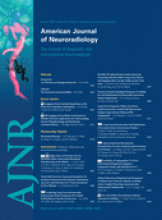Research ArticleSpine
T2 Relaxation Times Correlated with Stage of Lumbar Intervertebral Disk Degeneration and Patient Age
N.L. Marinelli, V.M. Haughton and P.A. Anderson
American Journal of Neuroradiology August 2010, 31 (7) 1278-1282; DOI: https://doi.org/10.3174/ajnr.A2080
N.L. Marinelli
V.M. Haughton

References
- 1.↵
- Kerttula L,
- Kurunlahti M,
- Jauhiainen J,
- et al
- 2.↵
- Boos N,
- Wallin A,
- Schmucker T,
- et al
- 3.↵
- 4.↵
- Antoniou J,
- Mwale F,
- Demers CN,
- et al
- 5.↵
- 6.↵
- 7.↵
- Weidenbaum M,
- Foster RJ,
- Best BA,
- et al
- 8.↵
- 9.↵
- Tertti M,
- Paajanen H,
- Laato M,
- et al
- 10.↵
- 11.↵
- Pfirrmann CW,
- Metzdorf A,
- Zanetti M,
- et al
- 12.↵
- Korhonen T,
- Karppinen J,
- Paimela L,
- et al
- 13.↵
- 14.↵
- 15.↵
- 16.↵
- 17.↵
- 18.↵
- Jenkins JP,
- Hickey DS,
- Zhu XP,
- et al
- 19.↵
- Boos N,
- Weissbach S,
- Rohrbach H,
- et al
- 20.↵
- Urban JP,
- McMullin JF
- 21.↵
- Griffith JF,
- Wang YX,
- Antonio GE,
- et al
In this issue
Advertisement
N.L. Marinelli, V.M. Haughton, P.A. Anderson
T2 Relaxation Times Correlated with Stage of Lumbar Intervertebral Disk Degeneration and Patient Age
American Journal of Neuroradiology Aug 2010, 31 (7) 1278-1282; DOI: 10.3174/ajnr.A2080
0 Responses
Jump to section
Related Articles
- No related articles found.
Cited By...
- Running acceleration correlates with T2 magnetic resonance imaging values of the lumber intervertebral disc
- Intervertebral Disc Elastography to Relate Shear Modulus and Relaxometry in Compression and Bending
- Variability of T2-Relaxation Times of Healthy Lumbar Intervertebral Discs is More Homogeneous within an Individual Than across Healthy Individuals
- We Need to Talk about Lumbar Total Disc Replacement
- T1{rho} and T2 Mapping of the Intervertebral Disk: Comparison of Different Methods of Segmentation
- Comparison of the T2 Relaxation Time of the Temporomandibular Joint Articular Disk between Patients with Temporomandibular Disorders and Asymptomatic Volunteers
- MR Imaging Assessment of Lumbar Intervertebral Disk Degeneration and Age-Related Changes: Apparent Diffusion Coefficient versus T2 Quantitation
This article has not yet been cited by articles in journals that are participating in Crossref Cited-by Linking.
More in this TOC Section
Similar Articles
Advertisement











